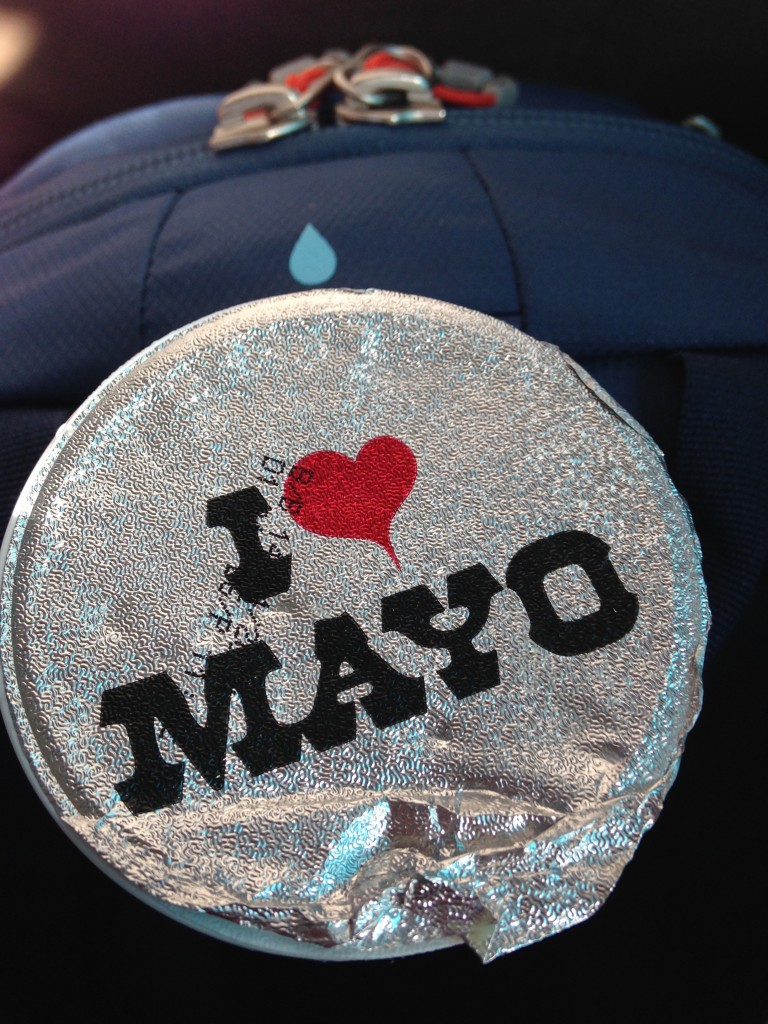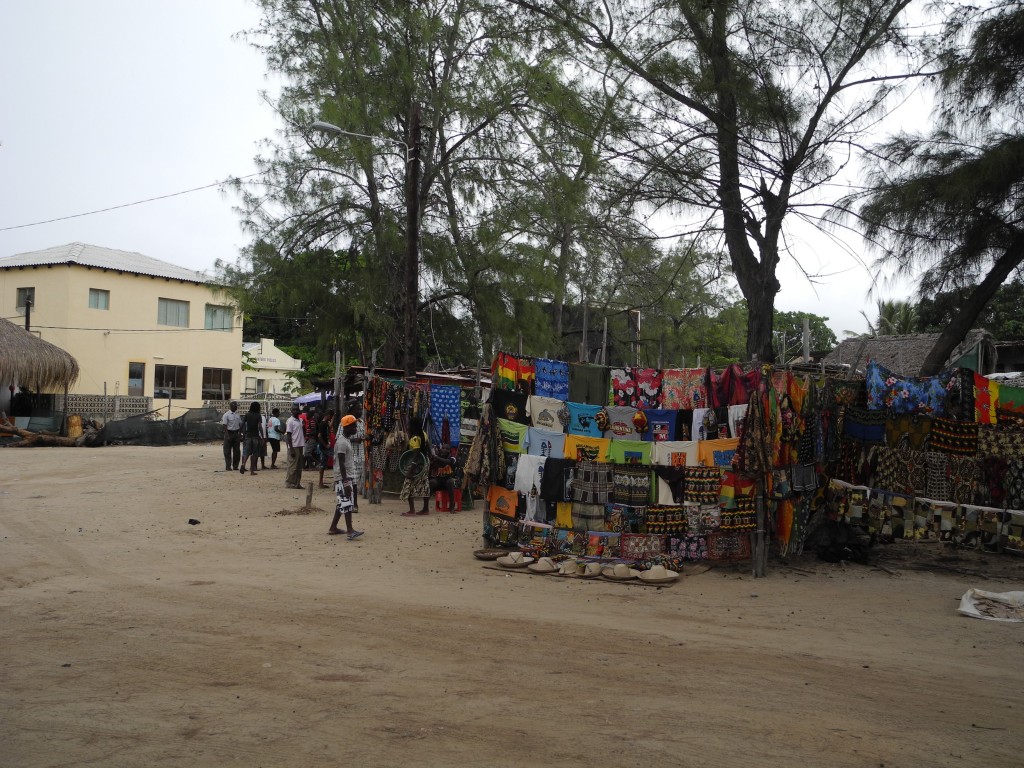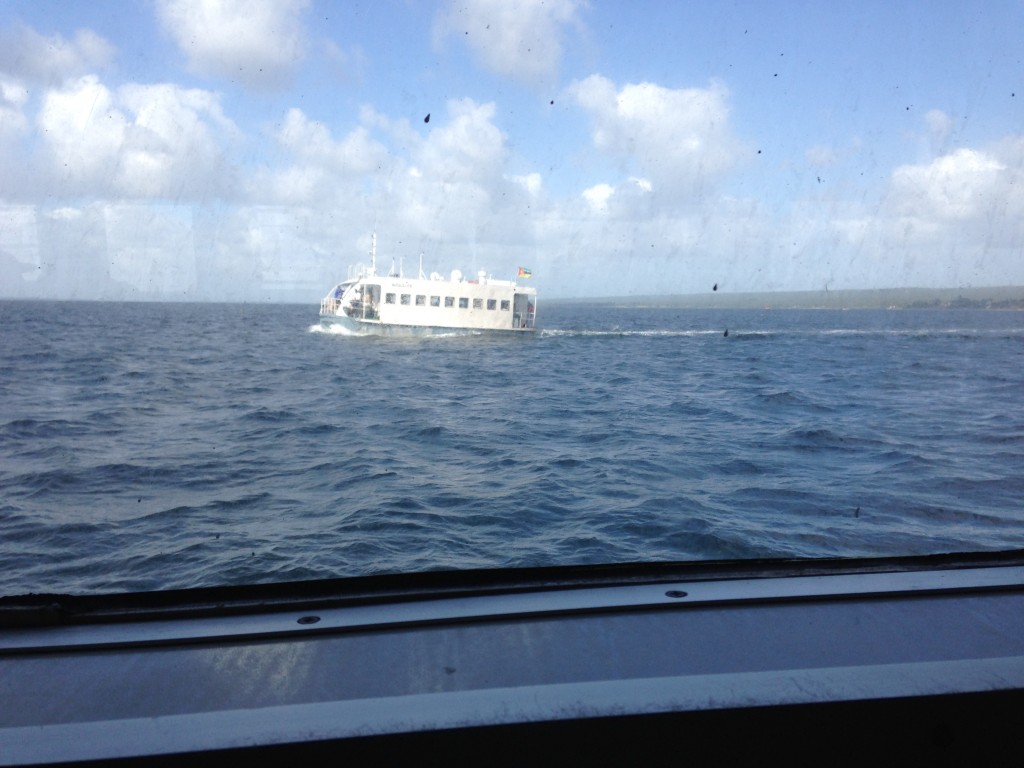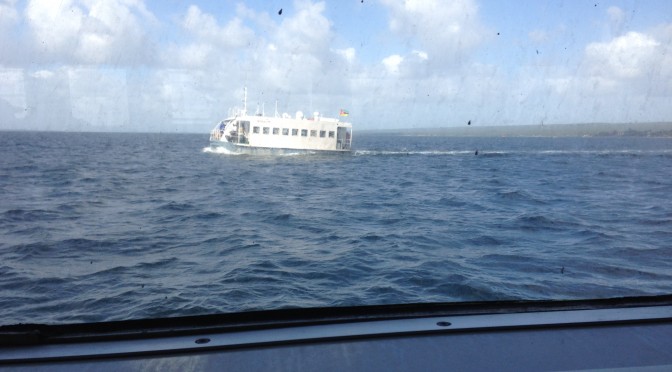When we arrived in Maputo, we had a vague idea that we could reach Tofo and Vilankulo “by bus,” but we did not have the details down. The process seemed fuzzy at times, and our best information came from reading the accounts – sometimes several years old – of other travelers. In the hope that it might help others plan their travel through southern Mozambique, here is how we made the journey:
Maputo to Tofo. As we have mentioned before, we took the Fatima’s Backpackers shuttle from Maputo to Tofo. Although Fatima’s does not actually operate the shuttle, it contracts with a local minibus operator to make the journey directly (albeit not nonstop) to Tofo. The shuttle leaves from Fatima’s Backpackers in Maputo around 5:00 a.m.1 and arrives at Fatima’s Nest in Tofo sometime in the early afternoon. (After leaving Fatima’s, the shuttle goes to the Maputo bus station to pick up more passengers before departing hopefully an hour or so later, and also stops a couple of times along the way at petrol stations for refueling, toilet breaks, and the purchase of refreshments.) The journey costs 700 mets per person, which is a decent price considering that taking the Fatima’s shuttle saves you the trouble of i) getting yourself to the bus station in Maputo – which was nowhere near where were staying, ii) locating, and then getting yourself and your baggage2 onto a bus heading to or through Maxixe, iii) taking the ferry across the bay to Inhambane, and iv) catching a chapa3 from Inhambane to Tofo.

Tofo to Barra. The central part of Barra is only several kilometers from Tofo (you can see the Barra lighthouse from Tofo and could theoretically walk there along the beach from Tofo), but we planned to take a taxi given our giant packs and plans to head to the Bay View Lodge, which is another several kilometers further down the beach in Barra. The guy manning the reception desk at Casa Barry (where we were staying in Tofo) offered to call us a taxi, but suggested that we first try to catch one in town, explaining that, if he called a taxi, the taxi would have to come from Inhambane, over twenty kilometers away, and thus would be more expensive. We waited around the main junction in town near the market, through a brief but intense rain shower and constant bombardment of vendors trying to sell us things (we finally succumbed on the coconut bread front), but there were no taxis to be found (we had seen taxis in this area on other days, so this might still be a viable option with more patience/luck). The woman at the Bay View Lodge in Barra had given us the number for an English-speaking taxi driver named Frank, so we called him and he arrived to take us in a van labeled “100% Frank.” For 400 mets, we got door to door ride from Casa Barry in Tofo to the Bay View Lodge in Barra.

Barra to Inhambane. The Bay View Lodge is several kilometers down the beach from the central part of Barra, which itself is not much more than collection of a few roadside stands vending fruits and drinks. It appeared the most of the people staying at the Lodge were South Africans who had arrived with their own vehicles. Given the lack of obvious transit options in any direction, we went for the easy option and just called 100% Frank for a ride to Inhambane.4 For 500 mets, we got a door to door ride from the Bay View Lodge in Barra to Pensão Pachiça in Inhambane.
Inhambane to Maxixe. We understood that a bus for Vilankulo would leave from Maxixe (the larger town across the bay from Inhambane) at around 10:00 a.m., and that it would be an approximately twenty-minute ferry ride from Inhambane to reach Maxixe. We were not pressed for time on the afternoon that we arrived in Inhambane and took a few minutes to scope out the ferry situation in advance. We easily located the ticket office at the base of the pier, where a ferry scheduled had been posted, but it appeared to be closed (this seems to have been due to the fact that our reconnaissance mission had been at an off time outside of commuting rush). Although we saw a larger, white ferry docked at the end of the pier, all of the passengers heading to Maxixe that afternoon were instead boarding small, crowded boats. When we arrived the next morning, however, a woman behind the counter in the ticket office quickly sold us tickets for 10 mets each and directed to us to head to the end of the pier to board the larger white ferry. (We breathed a collective sigh of relief when we saw this as we had been worried about trying to get on the smaller boat with our giant packs.)

Maxixe to Vilankulo. We disembarked the ferry in Maxixe and were almost immediately lost. We could plainly see where Google Maps thought the bus stand for Vilankulo-bound buses should be located, but there were no such buses to be found.5 We wandered around for a bit, very aware that we looked like walking targets – or just absurd – wearing our backpacking bags on our backs and our daypacks on our fronts, but only one guy seemed to be trying to lure us to his chapa. Dreading the idea of making a nearly 250 kilometer journey in a chapa that would be stopping every five minutes to pick up and drop off fares, we declined to follow him. Using my broken Portuñol (which, unfortuatley, is 99% Español and only 1% Português), I asked a vendor on the sidewalk for directions. She pointed us in the general direction, but it took the help of another man, who noticed that we looked lost, before we found a collection of buses near the market. Although we could not find a bus that would take us directly to Vilankulo,6 we found a proper, long-distance bus that would take us as far as Pembara, the town at which the main national highway (N1) – which runs from Maputo through Maxixe and Pembara to points much further north – has a junction to the road that leads 20 kilometers east to the coast at Vilankulo. We loaded ourselves and our packs onto the bus, paid 350 mets each for the approximately three-hour journey to Pembara, and were on our way up the coast not long after arriving in Maxixe.7 After the bus dropped us off at the dusty junction that was Pembara, we boarded a chapa to Vilankulo. Although the chapa ride from Pembara to Vilankulo was only supposed to cost us 15 mets each,8 the guy whose chapa we ended up taking from Pembara to Vilankulo, initially wanted to charge us 150 mets to transport us and our packs. This was ridiculous, as our packs were riding in the back and not taking up any passenger space. His chapa was filled and ready to leave, however, so instead of seeking an alternative form of transport with less potential gouging, but which might not have left for another hour, I haggled with him until we got the baggage charge down to a nominal fee (10 mets per bag). Katie and I then both crammed ourselves into the front passenger seat that had been left open for us and tried to remain calm as the driver, going more than 110 km/hour, then proceeded to nearly run over a bunch of kids walking home from school. Nonetheless, we made it to Vilankulo in one piece and lived to see another day.
1 Anyone who knows me could imagine how I felt about the timing of this journey, which required us to catch a prearranged taxi to Fatima’s well before 4:30 a.m. As we discovered, most long distance travel – as well as life in general – in Mozambique begins very early in the morning with rising of the sun.
2 As the Fatima’s shuttle is in the business of transporting backpackers, the minibus helpfully pulls a little trailer behind it to hold everyone’s packs. As this setup does not displace seats for potential paying customers, baggage (even of the large variety) rides free on the Fatima’s shuttle – as we discovered on our way to Vilankulo, something that is not always the norm in Mozambique.
3 Chapas are the privately owned minibuses, perpetually overstuffed with passengers and typically in a delicate state of repair, that ply the roads in Mozambique, serving as both local and long distance transport. They are a relatively inexpensive way to get around, but not exactly suited for travel with large packs.
4 Note that Barra and Tofo are not far from each other and equidistant from Inhambane, and we may have employed the same process if we were leaving from Tofo. Then again, maybe we could have found a minibus or other travelers in Tofo to share a taxi to Inhambane.
5 Unfortunately, our guidebook had no map of Maxixe and only sparse information in the text.
6 One guy claimed that a Vilankulo-bound bus would not be departing from Maxixe until around 1:00 p.m. – over three hours later – but he told us this as he was trying to get us to take his chapa.
7 Having known this this transit through Maxixe would be one of the most potentially harried aspects of our trip thus far, we both commented, in retrospect, on its relative ease – having endured much more frustrating/confusing/delayed transit misadventures while traveling in Asia and Latin America.
8 This is the cost listed in our late model guidebook, and the amount that was unsolicitedly repeated to us by the guys loading us onto the bus we took from Maxixe, as they were trying to assuage our concerns that we would be left with a large transport expense for the final leg from Pembara to Vilankulo.



very clear and detailed report of what we actually experience. tofo,barra,inhambane,maxixe we visited the last weeks and i can totally agree to the explained ways of african travelling. if you’re willing coming out of your comfort zone and keep in mind “thats africa” you can enjoy that adventure – which it really is. the next days we will travel from inhambane to vilanculos. so thank you for your sharing yourexleriences on your trip 🙂
Does this route take the number 1 along the coast or the inland route?
I will be travelling to Quissico / Inharrime form Maputo in January and am wondering if I can be dropped off there.
Any advice would be SO appreciated 🙂 🙂
Hi im looking for a cheap transfer from maputo to tofo at the 17th or 18th of january for one person.
Hope to try this soon, will share my experience